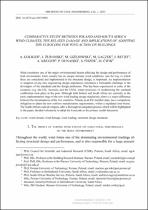 ResearchSpace
ResearchSpace
Comparative study between Poland and South Africa: Wind climates, the related damage and implications of adopting the Eurocode for wind action on buildings
JavaScript is disabled for your browser. Some features of this site may not work without it.
- ResearchSpace
- →
- Research Publications/Outputs
- →
- Journal Articles
- →
- View Item
| dc.contributor.author |
Goliger, Adam M

|
|
| dc.contributor.author |
Zuranski, J

|
|
| dc.contributor.author |
Gizejowski, M

|
|
| dc.contributor.author |
Gaczek, M

|
|
| dc.contributor.author |
Retief, J

|
|
| dc.contributor.author |
Kruger, A

|
|
| dc.contributor.author |
Dunaiski, P

|
|
| dc.contributor.author |
Fiszer, S

|
|
| dc.contributor.author |
Cwik, M

|
|
| dc.date.accessioned | 2013-11-19T05:41:09Z | |
| dc.date.available | 2013-11-19T05:41:09Z | |
| dc.date.issued | 2013-04 | |
| dc.identifier.citation | Goliger, A, Zuranski, J, Gizejowski, M, Gaczek, M, Retief, J, Kruger, A, Dunaiski, P, Fiszer, S and Cwik, M. 2013. Comparative study between Poland and South Africa: Wind climates, the related damage and implications of adopting the Eurocode for wind action on buildings. Archives of Civil Engineering, vol. 59(1), 51-95 | en_US |
| dc.identifier.issn | 1230-2945 | |
| dc.identifier.uri | http://www.degruyter.com/view/j/ace.2013.59.issue-1/ace-2013-0003/ace-2013-0003.xml | |
| dc.identifier.uri | http://hdl.handle.net/10204/7075 | |
| dc.description | Copyright: 2013 Versita. This is an Open Access journal. The journal authorizes the publication of the information herewith contained. Published in Archives of Civil Engineering, vol. 59(1), pp 51-95. | en_US |
| dc.description.abstract | Wind constitutes one of the major environmental factors affecting the design and performance of built environment. Each country has its unique climatic wind conditions, and the way in which these are considered and implemented in the structural design, is important. An implementation or adoption of any new engineering design stipulations introduces a formidable challenge to the developers of the standards and the design profession. This has been experienced in some of the countries (e.g. the UK, Australia and the USA), where processes of modernising the outdated codification took place in the past. Although both Poland and South Africa are currently at the early implementation stage of the new wind loading design stipulations, there is a major difference between the circumstances of the two countries. Poland, as an EU member state, has a compulsory obligation to adopt the new uniform standarisation requirements, within a stipulated time-frame. The South African code developers, after a thorough investigation process which will be highlighted in the paper, decided voluntarily to adopt the Eurocode as the primary model document. | en_US |
| dc.language.iso | en | en_US |
| dc.publisher | Versita | en_US |
| dc.relation.ispartofseries | Workflow;11708 | |
| dc.subject | Wind climate | en_US |
| dc.subject | Wind damage | en_US |
| dc.subject | Wind loading | en_US |
| dc.subject | Structural design standards | en_US |
| dc.title | Comparative study between Poland and South Africa: Wind climates, the related damage and implications of adopting the Eurocode for wind action on buildings | en_US |
| dc.type | Article | en_US |
| dc.identifier.apacitation | Goliger, A. M., Zuranski, J., Gizejowski, M., Gaczek, M., Retief, J., Kruger, A., ... Cwik, M. (2013). Comparative study between Poland and South Africa: Wind climates, the related damage and implications of adopting the Eurocode for wind action on buildings. http://hdl.handle.net/10204/7075 | en_ZA |
| dc.identifier.chicagocitation | Goliger, Adam M, J Zuranski, M Gizejowski, M Gaczek, J Retief, A Kruger, P Dunaiski, S Fiszer, and M Cwik "Comparative study between Poland and South Africa: Wind climates, the related damage and implications of adopting the Eurocode for wind action on buildings." (2013) http://hdl.handle.net/10204/7075 | en_ZA |
| dc.identifier.vancouvercitation | Goliger AM, Zuranski J, Gizejowski M, Gaczek M, Retief J, Kruger A, et al. Comparative study between Poland and South Africa: Wind climates, the related damage and implications of adopting the Eurocode for wind action on buildings. 2013; http://hdl.handle.net/10204/7075. | en_ZA |
| dc.identifier.ris | TY - Article AU - Goliger, Adam M AU - Zuranski, J AU - Gizejowski, M AU - Gaczek, M AU - Retief, J AU - Kruger, A AU - Dunaiski, P AU - Fiszer, S AU - Cwik, M AB - Wind constitutes one of the major environmental factors affecting the design and performance of built environment. Each country has its unique climatic wind conditions, and the way in which these are considered and implemented in the structural design, is important. An implementation or adoption of any new engineering design stipulations introduces a formidable challenge to the developers of the standards and the design profession. This has been experienced in some of the countries (e.g. the UK, Australia and the USA), where processes of modernising the outdated codification took place in the past. Although both Poland and South Africa are currently at the early implementation stage of the new wind loading design stipulations, there is a major difference between the circumstances of the two countries. Poland, as an EU member state, has a compulsory obligation to adopt the new uniform standarisation requirements, within a stipulated time-frame. The South African code developers, after a thorough investigation process which will be highlighted in the paper, decided voluntarily to adopt the Eurocode as the primary model document. DA - 2013-04 DB - ResearchSpace DP - CSIR KW - Wind climate KW - Wind damage KW - Wind loading KW - Structural design standards LK - https://researchspace.csir.co.za PY - 2013 SM - 1230-2945 T1 - Comparative study between Poland and South Africa: Wind climates, the related damage and implications of adopting the Eurocode for wind action on buildings TI - Comparative study between Poland and South Africa: Wind climates, the related damage and implications of adopting the Eurocode for wind action on buildings UR - http://hdl.handle.net/10204/7075 ER - | en_ZA |





